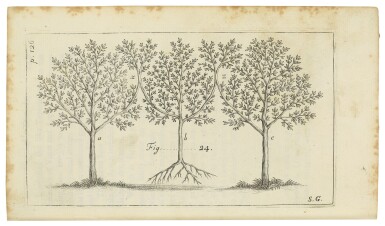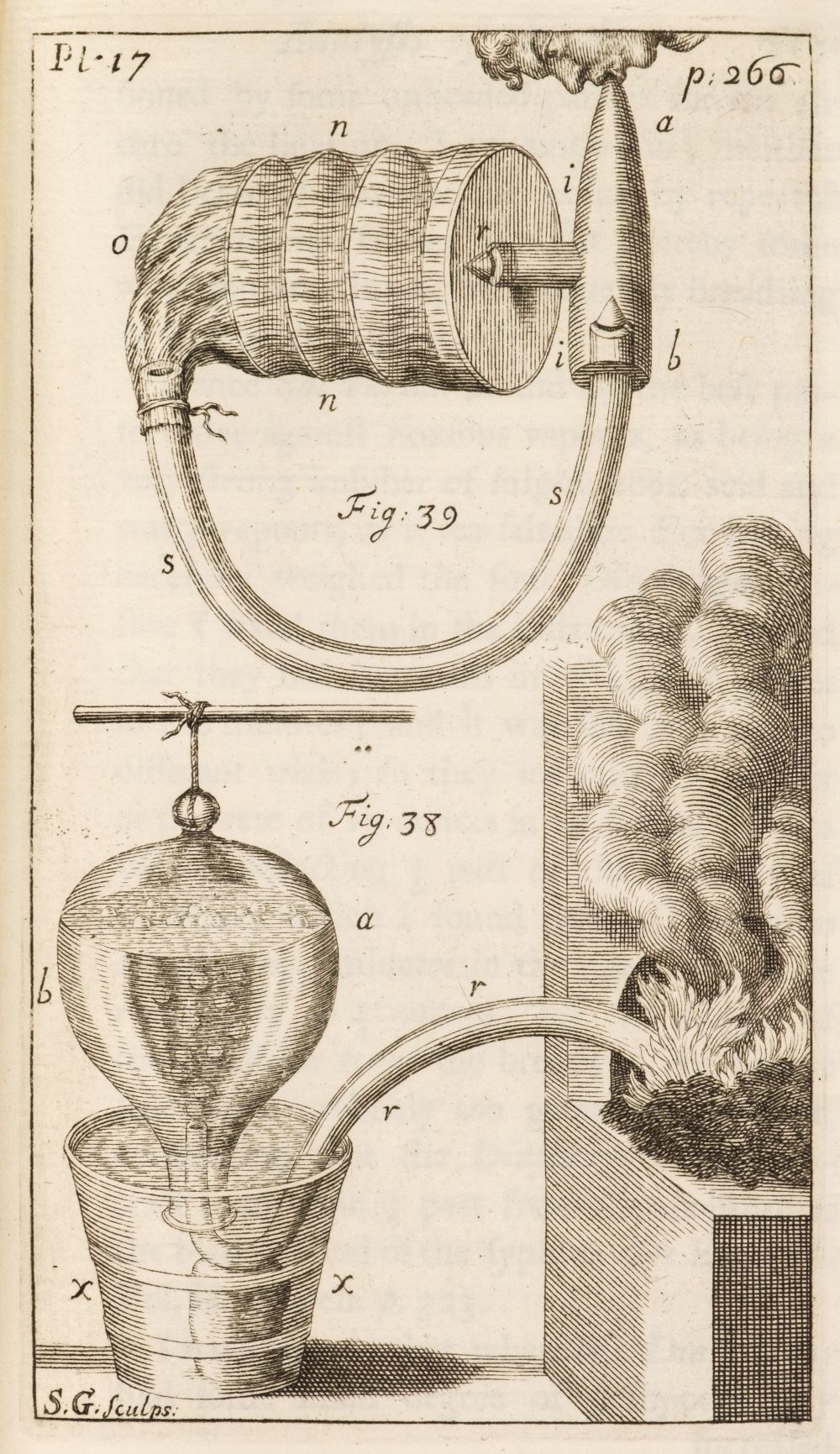HALES, Stephen (1677-1761). Vegetable Staticks: or, an Account of some Statical Experiments on the Sap in Vegetables: Being an Essay towards a Natural History of Vegetation. London: for W. and J. Innys and T. Woodward, 1727 -- Statical Essays: containing haemastaticks; or, an Account of some Hydraulick and Hydrostatical Experiments made on the Blood and Blood-Vessels of Animals. London: for W. Innys and R. Manby, and T. Woodward, 1733.
HALES, Stephen (1677-1761). Vegetable Staticks: or, an Account of some Statical Experiments on the Sap in Vegetables: Being an Essay towards a Natural History of Vegetation. London: for W. and J. Innys and T. Woodward, 1727 -- Statical Essays: containing haemastaticks; or, an Account of some Hydraulick and Hydrostatical Experiments made on the Blood and Blood-Vessels of Animals. London: for W. Innys and R. Manby, and T. Woodward, 1733. 2 volumes, 8 o (197 x 116 mm). 19 engraved plates by S. Gribelin [Vol. 1]. (p. 93 volume two with small tear across first three lines of text.) Contemporary calf, gilt (volume one rebacked preserving the original spine, extremities just touched). Provenance : Abraham Trembley (1710-1784), Swiss naturalist (signature at foot of title-page volume one); Penry Williams (bookplate in volume two). FIRST EDITIONS OF THESE IMPORTANT WORKS ON PLANT NUTRITION AND EXPERIMENTAL PHYSIOLOGY. Hales applied his training in biology and mathematics (including physics) to make important scientific investigations presented in these separately published volumes. In the first volume, Vegetable Staticks, Hales described his investigations of plant physiology, including the movement of water in plants, and outlined the three factors of water movement: root suction, root pressure and leaf suction. He also established that plants lose water continuously during transpiration through leaves. His quantitative measurements of these phenomena enabled him to show that the rate of transpiration varied with temperature. Hales established that plants do not have a true circulation system and he developed techniques of measuring the varying growth rates in different plant structures. The second volume, or Haemastaticks "contains the studies on blood pressure which establish Hales as one of the founders of modern experimental physiology. The application of the principle of the pressure-gauge or manometer enabled him to measure blood pressure during the contraction of the heart. He computed the circulation rate and estimated the velocity of the blood in the veins, arteries and capillary vessels. By showing that the capillary vessels are liable to constriction and dilation he made an important contribution both to the study of physiology and the practice of the physician of today... Hales's work marked the greatest advance in the physiology of the circulation between Harvey and the introduction of the mercury manometer and other instruments for the measurement of blood pressure by J.L.M. Poiseuille in 1828" ( PMM ). From the library of distinguished naturalist ABRAHAM TREMBLEY who in 1740 electrified the scientific world with his discovery that Chlorohydra viridissima was "definitely animal, even though it contained chlorophyll - a fact even more astonishing - and possessed powers of multiplication from artificial division hitherto thought to be unique to plants. Trembley first demonstrated the hydra's regenerative abilities by bisecting a specimen horizontally, so that the tentacles were confined to one part; he then observed the regeneration of both fragments over the course of several days, until two complete and indistinguishable organisms had been formed. In further investigations Trembley... demonstrated that a hydra could survive and feed after being turned inside out... and performed the first permanent graft of animal tissues by inserting one hydra within another. He was also the first to describe cell division of a sort in the fission of a protozoan" (Norman). In 1757 Trembley married Miss Von der Strassen, whose name also appears at the foot of the title-page of volume one. A FINE BRIGHT SET, INCLUDING BOTH FIRST EDITIONS. Dibner Heralds of Science 26; Garrison-Morton 765 ( Haemastaticks ); Grolier/Horblit 45a and 45b; Grolier Medicine 41; Heirs of Hippocrates 784; Henrey 777-78; NLM/Blake, p.194; Norman 970; Osler 1081; PMM 189; Waller 11527; Wellcome III, p.194. (2)
HALES, Stephen (1677-1761). Vegetable Staticks: or, an Account of some Statical Experiments on the Sap in Vegetables: Being an Essay towards a Natural History of Vegetation. London: for W. and J. Innys and T. Woodward, 1727 -- Statical Essays: containing haemastaticks; or, an Account of some Hydraulick and Hydrostatical Experiments made on the Blood and Blood-Vessels of Animals. London: for W. Innys and R. Manby, and T. Woodward, 1733.
HALES, Stephen (1677-1761). Vegetable Staticks: or, an Account of some Statical Experiments on the Sap in Vegetables: Being an Essay towards a Natural History of Vegetation. London: for W. and J. Innys and T. Woodward, 1727 -- Statical Essays: containing haemastaticks; or, an Account of some Hydraulick and Hydrostatical Experiments made on the Blood and Blood-Vessels of Animals. London: for W. Innys and R. Manby, and T. Woodward, 1733. 2 volumes, 8 o (197 x 116 mm). 19 engraved plates by S. Gribelin [Vol. 1]. (p. 93 volume two with small tear across first three lines of text.) Contemporary calf, gilt (volume one rebacked preserving the original spine, extremities just touched). Provenance : Abraham Trembley (1710-1784), Swiss naturalist (signature at foot of title-page volume one); Penry Williams (bookplate in volume two). FIRST EDITIONS OF THESE IMPORTANT WORKS ON PLANT NUTRITION AND EXPERIMENTAL PHYSIOLOGY. Hales applied his training in biology and mathematics (including physics) to make important scientific investigations presented in these separately published volumes. In the first volume, Vegetable Staticks, Hales described his investigations of plant physiology, including the movement of water in plants, and outlined the three factors of water movement: root suction, root pressure and leaf suction. He also established that plants lose water continuously during transpiration through leaves. His quantitative measurements of these phenomena enabled him to show that the rate of transpiration varied with temperature. Hales established that plants do not have a true circulation system and he developed techniques of measuring the varying growth rates in different plant structures. The second volume, or Haemastaticks "contains the studies on blood pressure which establish Hales as one of the founders of modern experimental physiology. The application of the principle of the pressure-gauge or manometer enabled him to measure blood pressure during the contraction of the heart. He computed the circulation rate and estimated the velocity of the blood in the veins, arteries and capillary vessels. By showing that the capillary vessels are liable to constriction and dilation he made an important contribution both to the study of physiology and the practice of the physician of today... Hales's work marked the greatest advance in the physiology of the circulation between Harvey and the introduction of the mercury manometer and other instruments for the measurement of blood pressure by J.L.M. Poiseuille in 1828" ( PMM ). From the library of distinguished naturalist ABRAHAM TREMBLEY who in 1740 electrified the scientific world with his discovery that Chlorohydra viridissima was "definitely animal, even though it contained chlorophyll - a fact even more astonishing - and possessed powers of multiplication from artificial division hitherto thought to be unique to plants. Trembley first demonstrated the hydra's regenerative abilities by bisecting a specimen horizontally, so that the tentacles were confined to one part; he then observed the regeneration of both fragments over the course of several days, until two complete and indistinguishable organisms had been formed. In further investigations Trembley... demonstrated that a hydra could survive and feed after being turned inside out... and performed the first permanent graft of animal tissues by inserting one hydra within another. He was also the first to describe cell division of a sort in the fission of a protozoan" (Norman). In 1757 Trembley married Miss Von der Strassen, whose name also appears at the foot of the title-page of volume one. A FINE BRIGHT SET, INCLUDING BOTH FIRST EDITIONS. Dibner Heralds of Science 26; Garrison-Morton 765 ( Haemastaticks ); Grolier/Horblit 45a and 45b; Grolier Medicine 41; Heirs of Hippocrates 784; Henrey 777-78; NLM/Blake, p.194; Norman 970; Osler 1081; PMM 189; Waller 11527; Wellcome III, p.194. (2)















Try LotSearch and its premium features for 7 days - without any costs!
Be notified automatically about new items in upcoming auctions.
Create an alert